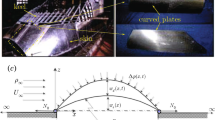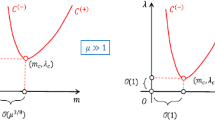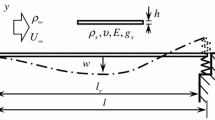Abstract
This paper visits the stability, bifurcations and post-critical behaviors of a nonlinear curved plate in a subsonic axial flow. The curved plate is simply supported and subjected to an initial horizontal tension. The plate is initially curved, and the initial shape is modeled by a shallow shell with constant curvature. The airflow is assumed incompressible, and the fluid force is considered as the sum of two parts: One is due to the plate deformation, and the other is to the plate initial shape. The Laplace’s equation is solved for the fluid force by placing a series of time-independent sources on the plate. The nonlinear axial strain due to large deformation is considered for the potential energy of the plate. Results show that the system has a fundamental and four bifurcated equilibrium solutions. The fundamental bifurcation is always supercritical; however, the secondary bifurcation is either supercritical or subcritical. The bifurcation regions are analyzed in parametric planes, and eight typical bifurcation processes are explored. There appear jump phenomena between the two stable states of system after the fundamental bifurcation. The combinations of designed parameters, including the plate initial curvature, horizontal tension and flow velocity, highly influence the bifurcation behaviors of the plate.













Similar content being viewed by others
References
Raghunathan, R.S., Kim, H.D., Setoguchi, T.: Aerodynamics of high-speed railway trains. Prog. Aerosp. Sci. 38, 469–514 (2002)
Ding, S.S., Li, Q., Tian, A.Q., Du, J., Liu, J.L.: Aerodynamic design on high-speed trains. Acta Mech. Sinica 32(2), 215–232 (2016)
Li, P., Yang, Y.R., Zhang, M.L.: Melnikov’s method for chaos of a two-dimensional thin panel in subsonic flow with external excitation. Mech. Res. Commun. 38, 524–528 (2011)
Dowell, E.H.: Aeroelasticity of Plates and Shells. Noordhoff International Publishing, Leyden (1975)
Paidoussis, M.P.: Fluid-Structure Interactions. Slender Structures and Axial Flow, 1st edn. Elsevier Academic Press, London (2004)
Bisplinghoff, R.L., Ashley, H., Halfman, R.L.: Aeroelasticity. Dover publications Inc, Mineola, NewYork (1955)
Li, P., Yang, Y.R., Xu, W., Chen, G.: On the aeroelastic stability and bifurcation structure of subsonic nonlinear thin plates subjected to external excitation. Arch. Appl. Mech. 82, 1251–1267 (2012)
Kornecki, A., Dowell, E.H., O’Brien, J.: On the aeroelastic instability of two-dimensional panels in uniform incompressible flow. J. Sound Vib. 47, 163–178 (1974)
Huang, J.L., Su, R.K.L., Lee, Y.Y., Chen, S.H.: Nonlinear vibration of a curved beam under uniform base harmonic exciation with quadratic and cubic nonlinearities. J. Sound Vib. 330, 5151–5164 (2011)
Choi, S.T., Chou, Y.T.: Vibration analysis of non-circular curved panels by the differential quadrature method. J. Sound Vib. 259, 525–539 (2003)
Yamaguchi, T., Nagai, K., Qian, Q.: Chaotic vibrations of a cylindrical shell-panel with an in-plane elastic-support at boundary. Nonlinear Dyn. 13, 259–277 (1997)
Bolotin, V.V.: Nonconservative Problems of Theroy of Elastic Stability. Macmillan, New York (1963)
Dowell, E.H.: Nonlinear flutter of curved plate. AIAA J. 7, 424–431 (1969)
Dowell, E.H.: Nonlinear flutter of curved plate, II. AIAA J. 8, 259–261 (1970)
Anderson, W.J.: Experiments on the flutter of flat and slightly curved panels at Mach number 2.81. Air Force Office of Scientific Research TN 2996, June 1962, California Institute of Technology, Pasadena, California
Azzouz, M.S., Mokthar, W.A.: Fluid structure interaction nonlinear fllutter of cyclindrial panels. AIAA, p. 693 (2006)
Azzouz, M.S., Mei, C.: Finite element time domain-model formulation for nonlinear flutter of cyclindrical panels. AIAA, p. 1732 (2006)
Librescu, L., Marzocca, P., Silva, W.A.: Supersonic fluter and post-flutter of geometrically imperfect cylindrical panels. J. Spacr. Rockets 39(5), 802–812 (2002)
Zhang, R.L., Yang, Z.C.: Bifurcation of the curved panel in supersoinic air flow. Chin. J. Theor. Appl. Mech. 42, 863–869 (2010). (in Chinese)
Yang, Z.C., Zhou, J., Gu, Y.S.: Nonlinear thermal flutter of heated curved panels in supersonic air flow. Chin. J. Theor. Appl. Mech. 44, 30–38 (2012). (in Chinese)
Fazelzadeh, S.A.: Chaotic behavior of nonlinear curved-panel in a supersoinc flow. Dyn. Contin. Discrete Ser. B 14, 793–809 (2007)
Holmes, P.J.: Pipes supported at both ends cannot flutter. J. Appl. Mech. ASME 45, 619–621 (1978)
Wang, L., Dai, H.L., Qian, Q.: Dynamics of simply supported fluid-conveying pipes with geometric imperfections. J. Fluids Struct. 12, 97–106 (2012)
Dodds Jr., H.L., Runyan, H.L.: Effect of high velocity fluid flow on the bending vibrations and static divergence of a simply supported pipe. NASA Technical Note, p. D-2870 (1965)
Pignataro, M., Rizzi, N., Luongo, A.: Stability, Bifurcation and Postcritical Behavior of Elastic Structures. Elsevier Science Publishing B.V., NewYork (1991)
Acknowledgements
This work is supported by the National Natural Science Foundation of China (Grant Nos: 11302183; 11372257; 11072204) and the Applied and Basic Research Plans of Sichuan Province of China (Grant No: 2015JY0083).
Author information
Authors and Affiliations
Corresponding author
Additional information
Publisher's Note
Springer Nature remains neutral with regard to jurisdictional claims in published maps and institutional affiliations.
Appendix
Appendix
The expression of \(\Delta _1\) in Eq. (3.3) is:
where
The expression of \(\Delta _2\) in Eq. (3.3) is:
where
The expression of b in Eq. (3.19) and the coefficients in Eq. (3.20) are:
where
Rights and permissions
About this article
Cite this article
Li, P., Zhang, D., Li, Z. et al. Bifurcations and post-critical behaviors of a nonlinear curved plate in subsonic airflow. Arch Appl Mech 89, 343–362 (2019). https://doi.org/10.1007/s00419-018-1471-x
Received:
Accepted:
Published:
Issue Date:
DOI: https://doi.org/10.1007/s00419-018-1471-x




